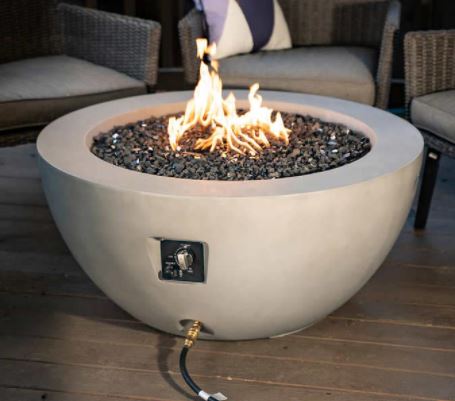Whether it’s a fireplace, fire bowl, fire pit, any feature is sure to become a focal point and central gathering place of landscape design. Outdoor fire features are divided into two categories based on fuel type: Wood and Natural Gas. Most gas-burning fire pits, fire bowls, or fireplaces run on liquid propane, but they can set up to burn natural gas. A wood-burning fire pit is a campfire ring taken to the next level. It is meant for burning standard split firewood logs. Wood vs. Gas Fire Pit
Wood vs. Gas Burning
When selecting a wood or gas fire pit, two main things to consider are overall felt and convenience. In terms of comfort, the gas fire pit wins hands down. The best part about the gas-burning is that it is simply turned on or off by just pushing a button. No wood to be gathered, chopped, or stored. The burn of either natural gas or propane means there’s no mess to clean up afterward; you will also not have to deal with ever-present smoke that comes with wood burning applications. We have set near a fire pit for the evening to wake the next day smelling like a chimney. That’s not the case with gas. Wood vs. Gas Fire Pit
For convenience, gas-burning systems are excellent but do have their downfalls. They are expensive to install. The gas fire needs either a gas line to form home by a plumber or use a propane tank to fuel the fire. Although chances are slim, tanks and gas lines bring the potential for a gas leak. Fire Pit
Compared to gas appliances, they fall short of heat compared to wood burning. Wood burning features feel and look more traditional. You can quickly get heat from wood because it burns hotter than natural and propane gas. However, outdoor cooking is also easier with wood-burning applications than a gas one. There’s quite like the rustic smells and crackling sounds of a natural cedar burning fireplace. If you want an authentic, rustic feel-to-fire feature, we will recommend wood burning.
Factors to Consider in Your Decision Gas or Wood
It’s essential to realize that virtually fire pit design can be adapted for either gas or wood fuel type. A nearly wood-burning fire pit can easily be converted to gas by installing an insert, available for $100 to $350. It depends on the size. Wood vs. Gas Fire Pit
So, you will need to consider the main thing when deciding which type of fuel to use are factors related to the fuel itself. So, here we will compare some of those factors to make the best choice for your outdoor living setup.
Installation Time: Wood vs. Gas Fire Pit
Typically, wood is cheaper than gas if you’ve your woodlot. The wood-burning fire pit is also less expensive to install and built-in 50% to 75% of the time it takes to install a gas burning unit. However, it’s essential to consider time as an expense. If you never split and chop your wood, you will still have to spend time ordering, seasoning, stacking, arranging, and carrying it.
Fuel: Wood vs. Gas Fire Pit
Do you live in a suburban home with a gas line already in place? Or a remote rural area with plenty of firewood nearby? Consider that if you’re burning propane, the property must be accessible to the delivery truck. Wood vs. Gas Fire Pit
Fuel storage
A propane-burning fire pit will require a storage tank. You may have one from 20 to 100-gallon tanks. It depends on how often you use it. So, no one wants to spend their time starting at the gas tank side, so you will want to be sure you have an out-of-way corner to place it in or develop a creative landscaping solution to hide it. Wood vs. Gas Fire Pit
However, the firewood needs storage space on the property. Consider where you stack wood without it detracting from the home’s appearance. Don’t stack it up against a wood-framed house. Firewood can harbor termites. Wood vs. Gas Fire Pit
Safety: Wood vs Gas Fire Pit
With firewood, necessary safety measures always are taken, which include woodcutting with extreme caution, properly stacking firewood in the fire pit, and put out the fire when finished, to name a few. When you use gas, there’s no possibility of gas leaks: Additionally, it’s rare when your fire pit is installed professionally.
Convenience
Firewood can be messy; if you never want to deal with sweeping up its bark, you may be happier with gas. Also, gas is easier to use than wood. Starting a gas fire pit is a matter of holding a lighter and flipping a switch to it.
Environmental Considerations: Wood vs Gas Fire Pit
Gas is far clean-burning than wood, so environmentally, it’s a toss-up. Indeed, wood is sensitive to smoke, or if your family member has asthma, gas will be the best option for you. Wood vs. Gas Fire Pit
Pros and Cons of Wood vs. Gas Burning
Pros for wood-burning
Hotter
The crackling cadre sound is hard to beat
Traditional looking flame
Better for cooking
Cheaper to install
Cons for Wood
Hassle of storing and chopping wood
It gets the smell of smoke
Difficult to clean
It takes a lot of time to start a fire
Pros for Gas burning
It’s quite convenient quickly turns off and on with a button
No ash or mess to clean up
No wood to store or chop
No smoke on your clothes
Comfortably enjoy flame without the fear of crackles
Cons for Gas
Bit Expensive
Use a propane tank or must run a gas line
Potential for gas leak
Less heat
Hiding the propane tank is tricky
Harder to cook
Less sounds and less rustic
Conclusion
So, there’s you have it: The pros and cons of wood vs. gas burning fire pits for you and your family. The significant factor is your personal choice. For some folks, a fire wouldn’t be the same without the smoke and crackle aroma of an excellent old-fashioned wood fire. Others choose and prefer the clean-burning convenience of gas.
We try to deliver the maximum information thoroughly. Hence, we highly recommend the wood-burning fire. It’s a traditional way to enjoy winter evenings with family and friends. However, both methods will provide you the enjoyable evenings with whichever method you decide to choose.
Would you like to read more about Wood vs Gas Fire Pit-related articles? If so, we invite you to take a look at our other tech topics before you leave!










